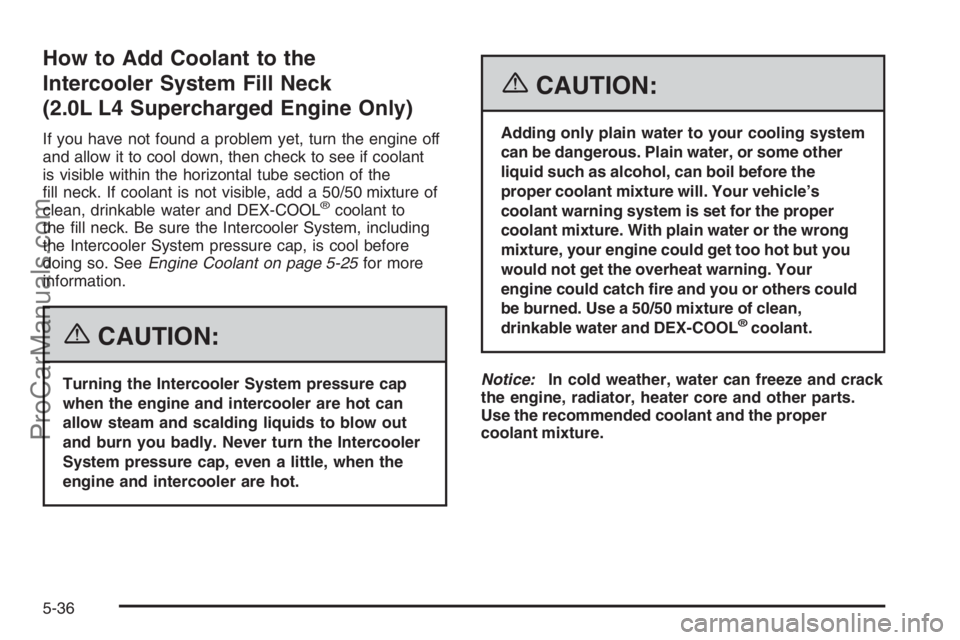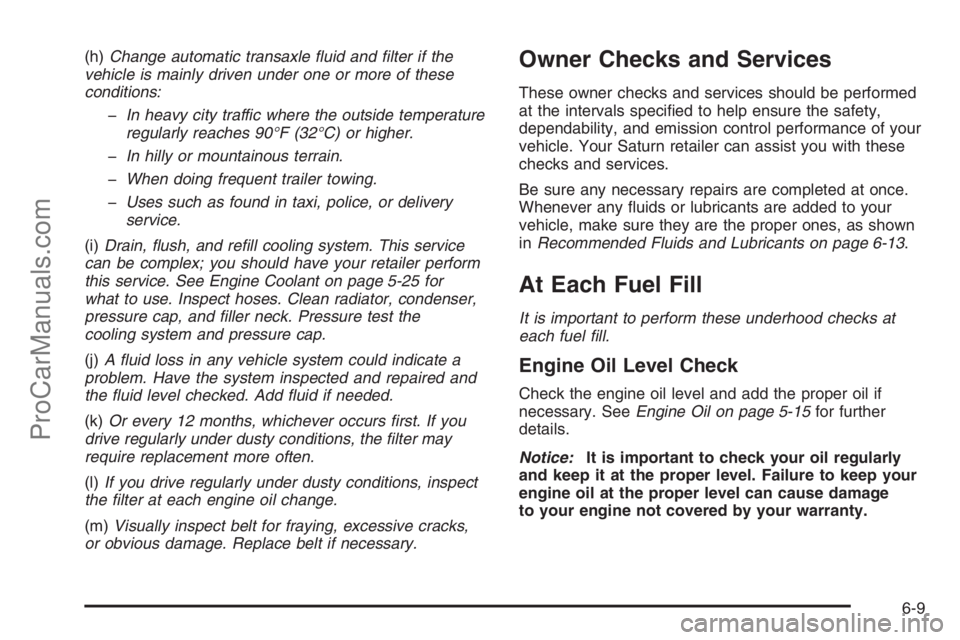radiator cap SATURN ION 2006 Owners Manual
[x] Cancel search | Manufacturer: SATURN, Model Year: 2006, Model line: ION, Model: SATURN ION 2006Pages: 392, PDF Size: 2.8 MB
Page 263 of 392

Checking Coolant
The surge tank is located on the driver’s side of the
engine compartment. SeeEngine Compartment
Overview on page 5-12for more information on location.
{CAUTION:
Turning the surge tank pressure cap when the
engine and radiator are hot can allow steam
and scalding liquids to blow out and burn you
badly. Never turn the surge tank pressure
cap — even a little — when the engine and
radiator are hot.
The vehicle must be parked on a level surface. When
your engine is cold, the coolant level should be near the
cold �ll line. When your engine is warm, the level
should be at the cold �ll line or a little higher.
If the COOLANT warning message comes on and stays
on, it means you are low on engine coolant.
5-27
ProCarManuals.com
Page 270 of 392

Notice:In cold weather, water can freeze and crack
the engine, radiator, heater core and other parts.
Use the recommended coolant and the proper
coolant mixture.
{CAUTION:
You can be burned if you spill coolant on hot
engine parts. Coolant contains ethylene glycol
and it will burn if the engine parts are hot
enough. Do not spill coolant on a hot engine.
1. You can remove the coolant surge tank pressure
cap when the cooling system, including the upper
radiator hose, is no longer hot. Turn the pressure
cap slowly counterclockwise about one-quarter of a
turn. If you hear a hiss, wait for that to stop. This
will allow any pressure still left to be vented out the
discharge hose.
2. Then keep turning the pressure cap slowly, and
remove it.
5-34
ProCarManuals.com
Page 271 of 392

3. Fill the coolant surge tank with the proper
DEX-COOL®coolant mixture, to the cold �ll line.
4. With the coolant surge tank pressure cap off, start
the engine and let it run until you can feel the upper
radiator hose getting hot. Watch out for the
engine cooling fan.By this time, the coolant level inside the coolant
surge tank may be lower. If the level is lower, add
more of the proper DEX-COOL
®coolant mixture
to the coolant surge tank until the level reaches the
cold �ll line.
5. Then replace the pressure cap. Be sure the
pressure cap is hand-tight and fully seated.
Check the level in the surge tank when the cooling
system has cooled down. If the coolant is not at
the proper level, repeat Steps 1 through 3 and reinstall
the pressure cap. If the coolant is not at the proper level
when the system cools down again, see your retailer.
5-35
ProCarManuals.com
Page 272 of 392

How to Add Coolant to the
Intercooler System Fill Neck
(2.0L L4 Supercharged Engine Only)
If you have not found a problem yet, turn the engine off
and allow it to cool down, then check to see if coolant
is visible within the horizontal tube section of the
�ll neck. If coolant is not visible, add a 50/50 mixture of
clean, drinkable water and DEX-COOL
®coolant to
the �ll neck. Be sure the Intercooler System, including
the Intercooler System pressure cap, is cool before
doing so. SeeEngine Coolant on page 5-25for more
information.
{CAUTION:
Turning the Intercooler System pressure cap
when the engine and intercooler are hot can
allow steam and scalding liquids to blow out
and burn you badly. Never turn the Intercooler
System pressure cap, even a little, when the
engine and intercooler are hot.
{CAUTION:
Adding only plain water to your cooling system
can be dangerous. Plain water, or some other
liquid such as alcohol, can boil before the
proper coolant mixture will. Your vehicle’s
coolant warning system is set for the proper
coolant mixture. With plain water or the wrong
mixture, your engine could get too hot but you
would not get the overheat warning. Your
engine could catch �re and you or others could
be burned. Use a 50/50 mixture of clean,
drinkable water and DEX-COOL
®coolant.
Notice:In cold weather, water can freeze and crack
the engine, radiator, heater core and other parts.
Use the recommended coolant and the proper
coolant mixture.
5-36
ProCarManuals.com
Page 280 of 392

Notice:If you leave your radio or other accessories
on during the jump starting procedure, they could
be damaged. The repairs would not be covered
by your warranty. Always turn off your radio and
other accessories when jump starting your vehicle.
3. Turn off the ignition on both vehicles. Unplug
unnecessary accessories plugged into the cigarette
lighter or the accessory power outlet. Turn off
the radio and all lamps that are not needed. This
will avoid sparks and help save both batteries.
And it could save the radio!
4. Open the hoods and locate the positive (+) and
negative (−) terminal locations on each vehicle.
You will not need to access your battery for jump
starting. Your vehicle has a remote positive (+)
and a remote negative (−) jump starting terminal.The remote positive (+) terminal is located on the
engine compartment fuse block, under a red
cap. SeeEngine Compartment Overview on
page 5-12for more information on location.
The remote negative (−) ground terminal is a bolt
located under the metal frame that supports
the radiator. It is at the front of the engine
compartment, on the driver’s side of the vehicle,
and is marked with a label that says GND (−).
{CAUTION:
An electric fan can start up even when the
engine is not running and can injure you.
Keep hands, clothing and tools away from
any underhood electric fan.
5-44
ProCarManuals.com
Page 354 of 392

Maintenance Footnotes
†The U.S. Environmental Protection Agency or the
California Air Resources Board has determined that the
failure to perform this maintenance item will not nullify
the emission warranty or limit recall liability prior to
the completion of the vehicle’s useful life. We, however,
urge that all recommended maintenance services be
performed at the indicated intervals and the
maintenance be recorded.
(a)Visually inspect brake lines and hoses for proper
hook-up, binding, leaks, cracks, cha�ng, etc. Inspect
disc brake pads for wear and rotors for surface
condition. Inspect drum brake linings/shoes for wear
or cracks. Inspect other brake parts, including drums,
wheel cylinders, calipers, parking brake, etc.
(b)Visually inspect front and rear suspension and
steering system for damaged, loose, or missing parts
or signs of wear.
(c)Visually inspect hoses and have them replaced if
they are cracked, swollen, or deteriorated. Inspect
all pipes, �ttings, and clamps; replace with genuine
Saturn parts as needed. To help ensure proper
operation, a pressure test of the cooling system and
pressure cap and cleaning the outside of the radiator
and air conditioning condenser is recommended at least
once a year.(d)Visually inspect wiper blades for wear or cracking.
Replace wiper blades that appear worn or damaged
or that streak or miss areas of the windshield.
(e)Make sure the safety belt reminder light and all your
belts, buckles, latch plates, retractors, and anchorages
are working properly. Look for any other loose or
damaged safety belt system parts. If you see anything
that might keep a safety belt system from doing its
job, have it repaired. Have any torn or frayed safety belts
replaced. Also look for any opened or broken airbag
coverings, and have them repaired or replaced.
The airbag system does not need regular maintenance.
(f)Lubricate all key lock cylinders, door hinges and
latches, hood hinges and latches, glove box hinges,
sunroof (if equipped), and any folding seat hardware.
More frequent lubrication may be required when
exposed to a corrosive environment. Applying silicone
grease on weatherstrips with a clean cloth will make
them last longer, seal better, and not stick or squeak.
(g)Check system for interference or binding and
for damaged or missing parts. Replace parts as needed.
Replace any components that have high effort or
excessive wear. Do not lubricate accelerator or cruise
control cables.
6-8
ProCarManuals.com
Page 355 of 392

(h)Change automatic transaxle �uid and �lter if the
vehicle is mainly driven under one or more of these
conditions:
�In heavy city traffic where the outside temperature
regularly reaches 90°F (32°C) or higher.
�In hilly or mountainous terrain.
�When doing frequent trailer towing.
�Uses such as found in taxi, police, or delivery
service.
(i)Drain, �ush, and re�ll cooling system. This service
can be complex; you should have your retailer perform
this service. See Engine Coolant on page 5-25 for
what to use. Inspect hoses. Clean radiator, condenser,
pressure cap, and �ller neck. Pressure test the
cooling system and pressure cap.
(j)A �uid loss in any vehicle system could indicate a
problem. Have the system inspected and repaired and
the �uid level checked. Add �uid if needed.
(k)Or every 12 months, whichever occurs �rst. If you
drive regularly under dusty conditions, the �lter may
require replacement more often.
(l)If you drive regularly under dusty conditions, inspect
the �lter at each engine oil change.
(m)Visually inspect belt for fraying, excessive cracks,
or obvious damage. Replace belt if necessary.Owner Checks and Services
These owner checks and services should be performed
at the intervals speci�ed to help ensure the safety,
dependability, and emission control performance of your
vehicle. Your Saturn retailer can assist you with these
checks and services.
Be sure any necessary repairs are completed at once.
Whenever any �uids or lubricants are added to your
vehicle, make sure they are the proper ones, as shown
inRecommended Fluids and Lubricants on page 6-13.
At Each Fuel Fill
It is important to perform these underhood checks at
each fuel �ll.
Engine Oil Level Check
Check the engine oil level and add the proper oil if
necessary. SeeEngine Oil on page 5-15for further
details.
Notice:It is important to check your oil regularly
and keep it at the proper level. Failure to keep your
engine oil at the proper level can cause damage
to your engine not covered by your warranty.
6-9
ProCarManuals.com